How To Apply Art Class Games To Your Course
Are your art lessons in need of a creative boost? Are you looking for innovative ways to engage your students and make learning a truly enjoyable experience? Look no further than the exciting world of Art Class Games!
These interactive and playful activities offer a unique approach to teaching art, transforming your classroom into a vibrant hub of creativity, collaboration, and fun. Whether you're a seasoned art teacher seeking fresh ideas or a newcomer to the field eager to experiment, art class games provide a versatile toolkit for inspiring your students and unlocking their full artistic potential.
In this comprehensive guide, we'll delve into the captivating realm of art class games. We'll explore their numerous benefits, discover how to seamlessly incorporate them into your curriculum, and uncover the top software tools to enhance your game experience.
Get ready to transform your art lessons from ordinary to extraordinary with the power of play!
What Is Art Class Games?
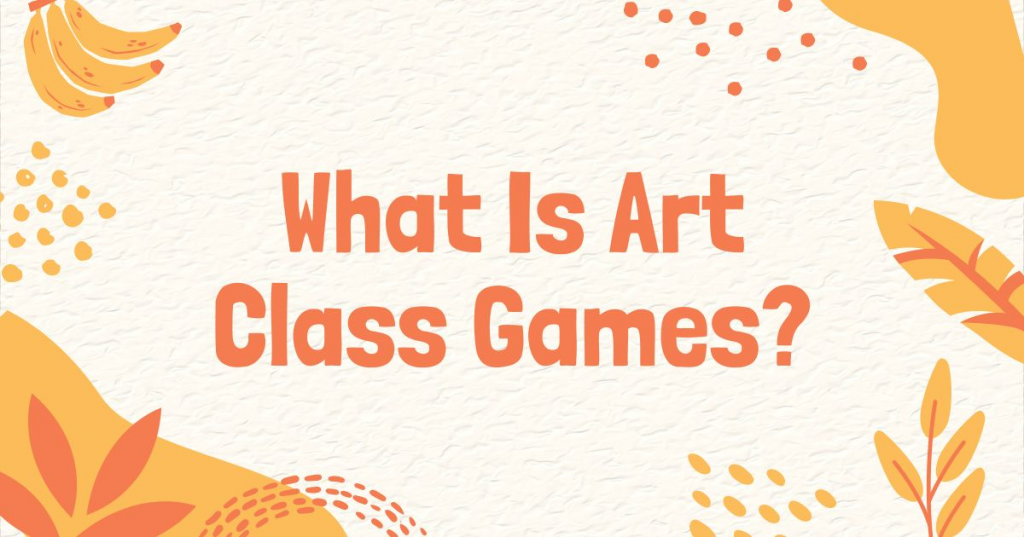
Art class games are a fantastic way to spark creativity, encourage collaboration, and teach important artistic concepts in an engaging way. These games go beyond traditional lectures and demonstrations, allowing students to actively participate in the learning process.
Art class games can take many forms:
Drawing and Painting Games: These could involve timed challenges, collaborative murals, or using unusual tools and materials.
Art History Trivia: A fun way to test knowledge of famous artists, artworks, and movements.
Sculpture and 3D Art Games: Building structures with unexpected materials or creating collaborative sculptures can be both fun and educational.
Digital Art Games: Using online platforms or apps for collaborative drawing, design challenges, or even virtual art exhibits.
Why Art Class Games Matter:
Engagement: Games keep students excited and motivated to learn.
Collaboration: Many games encourage teamwork and communication skills.
Skill Development: Games can help students improve their observation, problem-solving, and artistic techniques.
Fun: Let's face it, learning through play is simply more enjoyable!
In this blog post, we'll explore some of the best art class games for different age groups and skill levels. Whether you're an art teacher looking for fresh ideas or a student wanting to add some creativity to your studies, we've got you covered!
Check out our online courses on Creative Teaching Strategies or Drawing for Beginners!
Benefits Of Applying Art Class Games To Teaching
Art class games aren't just a fun way to break up the monotony of traditional teaching methods. They offer a wealth of benefits for both teachers and students:
Benefits for Students
The following are the main benefits for students when applying art class games in teaching:
Enhanced Engagement: Games transform learning into an adventure, captivating students' attention and making them eager to participate.
Boosted Creativity: Games encourage students to think outside the box, experiment with different techniques, and discover their unique artistic voices.
Improved Skill Development: Games provide a hands-on approach to learning, helping students develop critical skills like observation, problem-solving, and technical mastery.
Increased Collaboration: Many art class games involve teamwork and cooperation, fostering communication skills and a sense of community.
Reduced Stress and Anxiety: Playful activities create a relaxed and enjoyable learning environment, making students feel more comfortable taking risks and exploring their creativity.
Benefits for Teachers
The following are the main benefits for teachers when applying art class games in teaching:
Classroom Management: Games provide a structured and engaging way to manage the classroom, reducing disruptions and increasing student participation.
Differentiated Instruction: Games can be adapted to cater to different learning styles and skill levels, ensuring that all students have the opportunity to succeed.
Assessment Tool: Games offer a unique way to assess student understanding and progress in a fun and low-pressure setting.
Community Building: Games foster a sense of camaraderie and shared experience among students, creating a more positive and supportive classroom culture.
Professional Development: Exploring new and innovative teaching methods like art class games can revitalize your teaching practice and inspire your creativity.
Ultimately, art class games are a win-win for everyone involved. They make learning more enjoyable, effective, and memorable, while also fostering creativity, collaboration, and a lifelong love of art.
How To Apply Art Class Games Into Teaching
Ready to infuse your art lessons with some playful energy? Here's how to seamlessly integrate art class games into your curriculum:
Set Clear Goals
Before you embark on any game-based learning adventure, it's crucial to map out your destination. In other words, establish clear and specific learning objectives for the game.
Ask yourself:
What skills do I want my students to practice and improve? Are you focusing on color theory, composition, observational drawing, or perhaps art history knowledge?
What concepts do I want them to understand more deeply? Are you exploring different art movements, cultural influences, or the use of specific materials?
What kind of experience do I want to create for my students? Do you want them to collaborate, problem-solve, express their creativity, or simply have fun?
Once you have a clear understanding of your learning objectives, you can select games that are specifically designed to target those skills and concepts.
Choose the Right Game
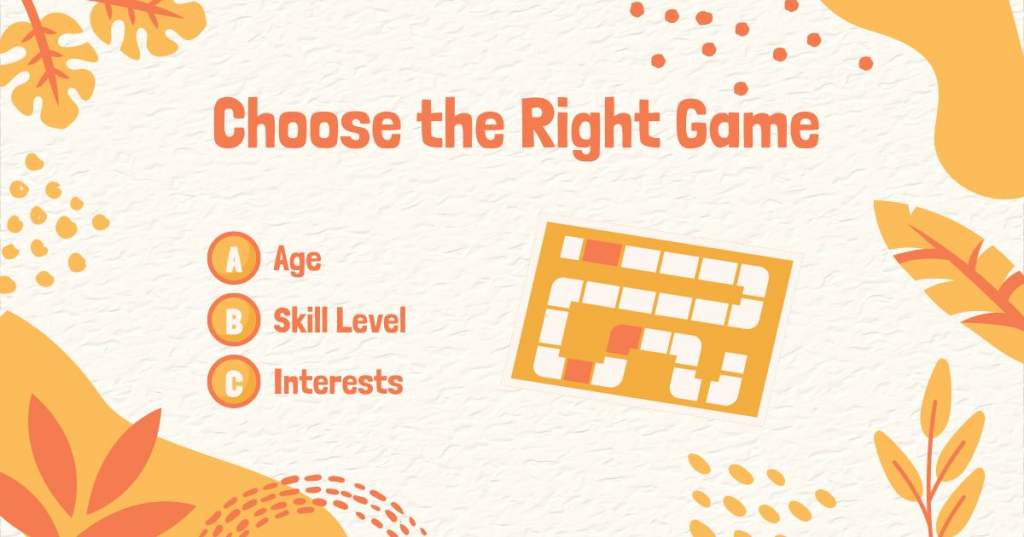
Selecting the right art class game is essential to ensure maximum engagement and learning. Just like a well-chosen paintbrush or a perfectly mixed color palette, the right game can elevate your lesson and bring out the best in your students. Here's how to find the perfect fit:
Consider Age and Developmental Stage
Elementary School: Younger students often thrive on games that involve physical movement, simple rules, and a focus on basic artistic skills like color recognition, shape identification, and creative expression.
Example: "Color Scavenger Hunt" – Students search the classroom or schoolyard for objects of specific colors, fostering observation skills and color awareness.
Middle School: Tweens and teens enjoy games that challenge their critical thinking, problem-solving abilities, and encourage artistic exploration.
Example: "Art History Pictionary" – Students draw famous artworks while their classmates try to guess the title and artist, reinforcing art knowledge in a fun way.
High School: Older students appreciate games that allow for deeper artistic expression, critical analysis, and connection to real-world issues.
Example: "Collaborative Mural Design" – Students work together to design and create a mural on a specific theme, promoting teamwork, communication, and social awareness.
Assess Skill Level
Beginners: Start with games that focus on foundational skills and build confidence. Avoid overly complex rules or activities that could frustrate novices.
Example: "Blind Contour Drawing" – Students draw an object without looking at their paper, improving hand-eye coordination and observational skills.
Intermediate: Choose games that offer a moderate challenge, encouraging students to push their boundaries and try new techniques.
Example: "Themed Still Life Challenge" – Students create a still life composition using a specific theme or color palette, developing their compositional skills and creativity.
Advanced: Opt for games that allow for more open-ended exploration, artistic interpretation, and critical analysis.
Example: "Art Critique Circle" – Students present their artwork to their peers for constructive feedback, fostering critical thinking and communication skills.
Tap into Interests
Pop Culture: Incorporate elements from popular movies, TV shows, music, or video games to make art class games more relevant and engaging for students.
Example: "Design a Movie Poster" – Students create a movie poster for a favorite film or a fictional story, combining art and storytelling.
Current Events: Use art class games to explore current events, social issues, or cultural phenomena.
Example: "Create a Protest Poster" – Students design posters that express their views on a social or political issue, fostering civic engagement and critical thinking.
Student Suggestions: Ask your students for game ideas! Their input can provide valuable insights into their interests and preferences.
By carefully considering your students' age, skill level, and interests, you can choose art class games that spark their creativity, ignite their passion for learning, and transform your classroom into a vibrant hub of artistic exploration.
Explain the Rules
Taking the time to thoroughly explain the rules and objectives of any art class game is crucial for a successful and enjoyable experience. Unclear instructions can lead to confusion, frustration, and ultimately derail the learning potential of the activity.
Here's how to ensure your instructions are crystal clear:
Break it Down: Explain the game step-by-step, using simple and age-appropriate language. Avoid jargon or overly complex terminology.
Visual Aids: If possible, use visual aids like diagrams, pictures, or even a quick demonstration to help students visualize the game mechanics.
Check for Understanding: After explaining the rules, ask questions to gauge student comprehension. "Can anyone summarize the goal of the game?" or "What happens if you do X?"
Repeat and Reinforce: Don't be afraid to reiterate the key points multiple times. Repetition helps solidify the rules in students' minds.
Provide Written Instructions: For more complex games, consider providing written instructions or a cheat sheet that students can refer to throughout the activity.
Examples:
Drawing Game: "In this game, you'll have two minutes to draw an object I describe. The goal is to be as creative and detailed as possible. You'll earn points for accuracy and originality."
Art History Trivia: "I'll show you a picture of a famous artwork. You'll have to guess the artist, title, and the art movement it belongs to. The first person to shout out the correct answer wins a point."
Collaborative Mural: "We'll be working together to create a mural on the theme of 'nature.' Each group will be responsible for a different section. We'll have 30 minutes to complete it, so communication and teamwork are key!"
By taking these extra steps to ensure clarity and understanding, you'll set the stage for a smooth, engaging, and educational art class game experience.
Adapt and Modify
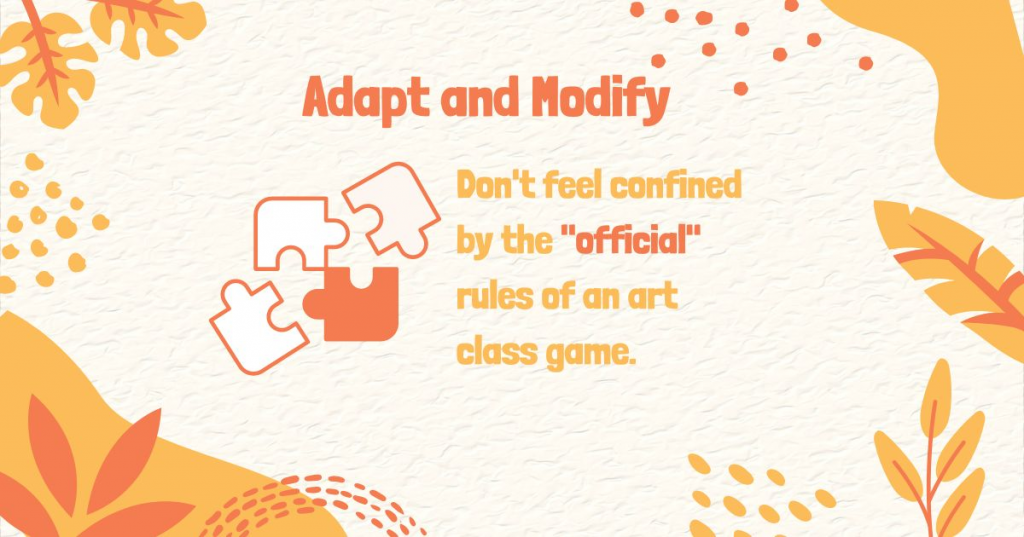
Don't feel confined by the "official" rules of an art class game. The beauty of games is their flexibility. Feel free to adjust them to match your students' unique needs, interests, and the specific skills you want to reinforce.
Here are some ways to make art class games your own:
Simplify or Complexify: If a game seems too challenging, break it down into smaller steps or offer more guidance. Conversely, if a game feels too easy, add extra challenges or layers of complexity to keep students engaged.
Incorporate Student Interests: Tailor games to your students' favorite themes or topics. For example, if they love superheroes, create a drawing game where they design their own hero costumes.
Use Different Materials: Don't limit yourself to traditional art supplies. Get creative and use recycled materials, natural objects, or even found objects from around the classroom.
Change the Time Frame: Some games might be more effective with shorter or longer time limits. Adjust the timing to fit the pace of your students and the goals of the activity.
Add a Competitive Element: If appropriate, introduce a friendly competition to add excitement and motivation. Consider team-based challenges or individual awards for creativity or skill.
Connect to Other Subjects: Integrate art class games with other areas of the curriculum. For example, a drawing game could incorporate math concepts like shapes and patterns.
By adapting and modifying art class games, you'll not only keep your students engaged but also create a more personalized and effective learning experience. So get creative, experiment, and have fun with it!
Create a Safe and Supportive Environment
Incorporating games into your art class is not just about the rules or the activity itself. It's about fostering an environment where students feel comfortable enough to let their creativity run wild. This means:
Encouraging Risk-Taking: Let students know it's okay to try new things, even if they don't turn out perfectly. Celebrate experimentation and the willingness to step outside of comfort zones.
Embracing Mistakes: Emphasize that mistakes are not failures, but valuable learning opportunities. Help students reframe their perspective on errors, seeing them as stepping stones on the path to artistic growth.
Celebrating Individuality: Encourage students to express their unique perspectives and styles. Avoid comparisons and competition, fostering an atmosphere of acceptance and appreciation for diverse artistic expressions.
Providing Constructive Feedback: Offer feedback that focuses on strengths and areas for growth, rather than criticism. Help students identify what's working well in their art and offer gentle suggestions for improvement.
Creating a Joyful Atmosphere: Infuse your classroom with laughter, playfulness, and a sense of wonder. Make art class a place where students feel excited to learn, explore, and express themselves freely.
By intentionally cultivating a safe and supportive environment, you empower students to take creative risks, embrace their individuality, and develop a lifelong love of art.
Make it Collaborative
Art isn't always a solitary pursuit. In fact, some of the most creative and memorable projects are born from collaboration! Whenever possible, choose art class games that encourage students to work together as a team.
Here's why collaborative art games are so impactful:
Build Communication Skills: Students must communicate effectively to share ideas, negotiate decisions, and solve problems together.
Foster Creative Synergy: When diverse perspectives and skillsets come together, the results can be truly amazing. Collaboration often sparks new ideas and approaches that wouldn't emerge in individual work.
Create a Sense of Community: Working together towards a common goal builds camaraderie and a sense of belonging. Students learn to appreciate each other's strengths and support each other's efforts.
Promote Problem-Solving: Collaborative projects often involve unexpected challenges. Working as a team, students learn to brainstorm solutions, compromise, and adapt to changing circumstances.
Prepare for the Real World: Collaboration is a vital skill in many professional fields. Art class games provide students with a fun and engaging way to practice teamwork and develop the skills they'll need to succeed in their future careers.
This will promote communication skills and a sense of community.
Tie it to the Curriculum
Don't let art class games exist in a vacuum! To maximize their educational impact, intentionally connect them to the concepts and skills you're already teaching in your regular art lessons. This integration reinforces learning, making the games feel more relevant and purposeful to students.
Here's how you can weave games into your curriculum:
Reinforce Specific Techniques: If you're teaching perspective drawing, play a game that challenges students to create drawings with exaggerated or distorted perspectives.
Explore Art History: Turn art history trivia into a game show format to review key artists and movements.
Practice Color Theory: Play a color mixing challenge where students have to create specific hues using limited palettes.
Develop Composition Skills: Design a collaborative drawing game where students take turns adding elements to a shared canvas, focusing on balance and visual interest.
Experiment with Different Mediums: Create a game that encourages students to experiment with different materials like clay, collage, or found objects, while exploring specific themes or techniques.
By intentionally linking games to your curriculum, you'll transform them from mere fun activities into powerful learning tools. Students will be more likely to remember the concepts they've learned through play, making the learning experience more engaging, effective, and lasting.
Debrief and Reflect
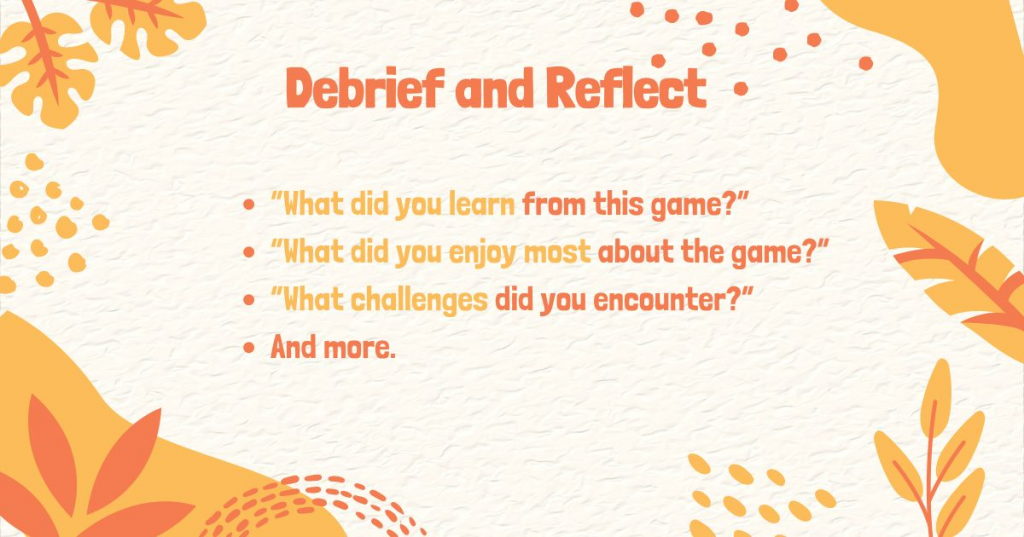
Taking the time to reflect and debrief after an art class game is crucial for maximizing the learning experience and strengthening the bond between you and your students.
This reflective process allows students to solidify their understanding of the concepts, articulate their thoughts and feelings, and develop critical thinking skills. It also provides valuable feedback for you as the teacher, allowing you to refine your approach and tailor future activities to better suit your students' needs.
Here are some key questions to guide the debriefing discussion:
What did you learn from this game? Encourage students to identify specific skills, techniques, or concepts they learned or practiced during the game.
What did you enjoy most about the game? This question helps you gauge what aspects of the game were most engaging and effective.
What challenges did you encounter? This provides insight into potential areas for improvement and helps students develop problem-solving strategies.
How did the game make you feel? Exploring emotions helps students connect their learning to their personal experiences and fosters self-awareness.
How could we improve this game? Inviting student input empowers them and makes them active participants in the learning process.
This reflection process can be a valuable learning experience.
Tips for Success on Art Class Game:
Start Small: If you're new to using games, start with simple activities and gradually incorporate more complex ones.
Variety is Key: Offer a diverse selection of games to keep things interesting and cater to different learning styles.
Have Fun! Your enthusiasm will be contagious. When you're having fun, your students will too.
Art class games are a powerful tool for fostering creativity, engagement, and a lifelong love of art. So don't be afraid to play, experiment, and discover the endless possibilities that games can bring to your courses!
Popular Software To Create Art Class Games
A wealth of innovative software tools are available to enhance your art class game experience. These platforms offer exciting ways to create interactive activities, collaborative projects, and virtual exhibits that will captivate your students' imaginations.
Here are popular options worth exploring:
Kahoot!
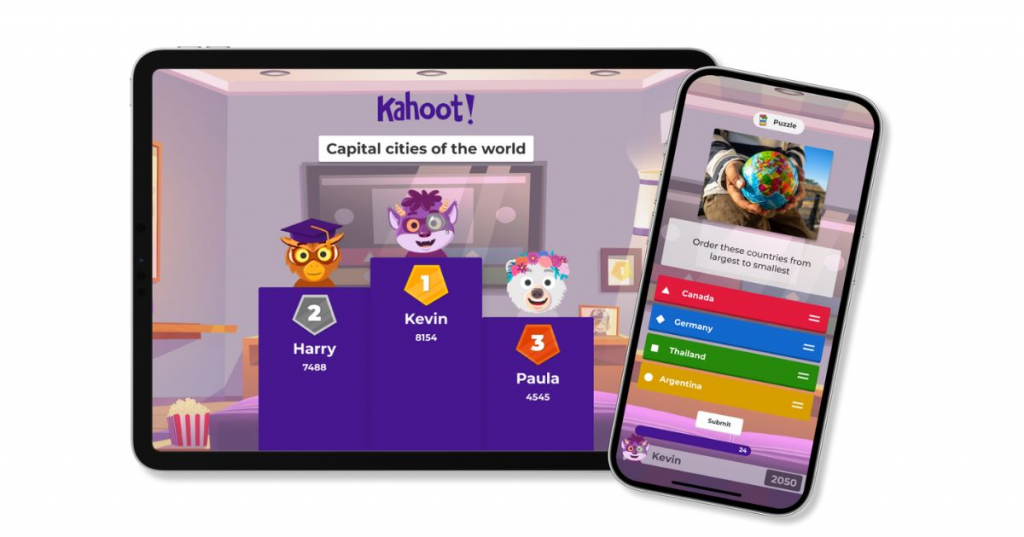
This versatile platform allows you to create custom quizzes, polls, and interactive challenges. Use it for art history trivia, identifying art movements, or even voting on favorite student artwork.
Google Arts & Culture
Dive into a vast collection of high-resolution images, virtual tours of museums, and interactive experiments related to art and culture. Use it to inspire creative writing prompts, spark discussions, or create virtual scavenger hunts.
Padlet
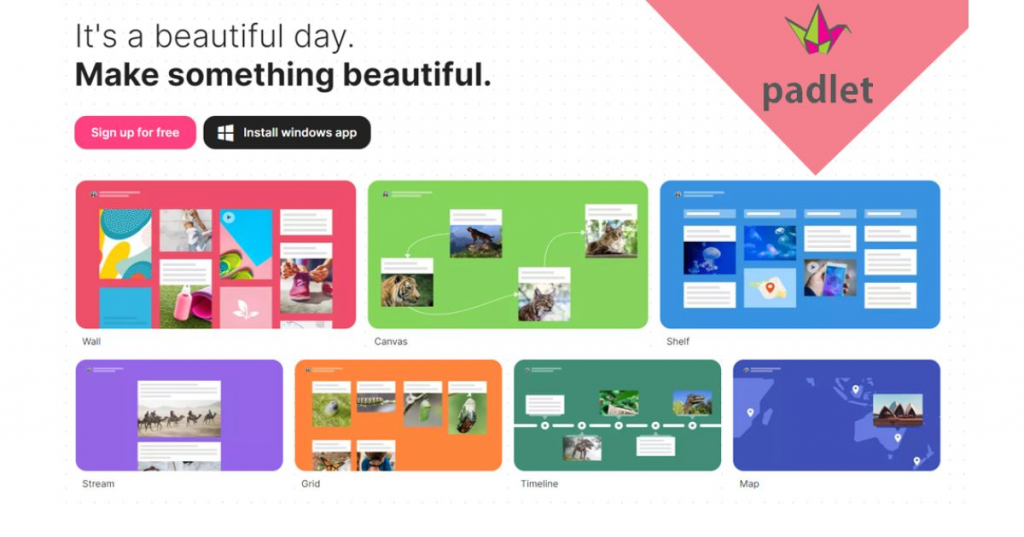
A collaborative digital bulletin board that lets students share their artwork, ideas, and reflections in a visually engaging way. Use it to create virtual galleries, gather feedback, or brainstorm collaborative projects.
Canva
An easy-to-use graphic design tool that empowers students to create digital posters, presentations, and even simple animations. Use it to design promotional materials for art shows, create visual aids for lessons, or explore digital collage techniques.
Procreate (for iPad)
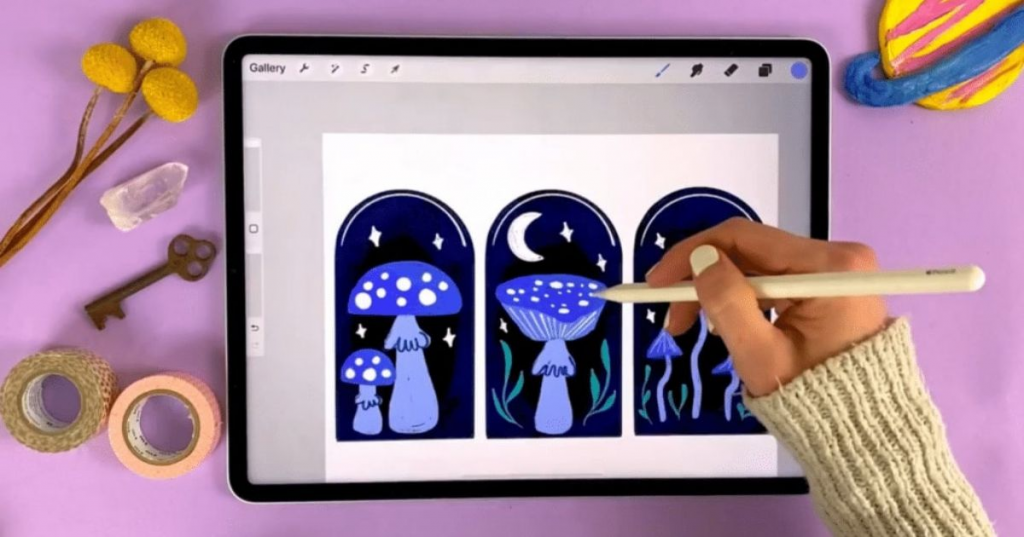
This powerful drawing and painting app offers a wide range of brushes, tools, and effects for digital artists. Use it to create collaborative murals, explore different art styles, or even create animated flipbooks.
These are just a few examples of the many tools available to enhance your art class games. Don't be afraid to experiment and discover the platforms that best suit your teaching style and your students' interests. Embrace the power of technology to unleash your creativity and make learning art a truly immersive and unforgettable experience!
Conclusion
Art class games offer a vibrant and dynamic way to ignite creativity, foster collaboration, and instill a lifelong love of art in students of all ages. By transforming learning into an interactive adventure, these games unlock the potential for deeper engagement, enhanced skill development, and a more joyful classroom experience. Whether you're incorporating classic drawing challenges, exploring digital art platforms, or creating custom quizzes, the possibilities are endless.
Remember, the most effective art class games are those that align with your learning objectives, cater to your students' interests, and encourage a playful spirit of exploration. So don't be afraid to experiment, adapt, and have fun along the way! By embracing the power of play, you'll empower your students to become confident, creative, and passionate artists who are eager to learn and grow.
We hope this blog post has inspired you to incorporate art class games into your teaching repertoire. SkillTrans offers a wide variety of courses to support your journey as an art educator. Explore SkillTrans course collections today and discover new ways to unleash your students' artistic potential!

Meet Hoang Duyen, an experienced SEO Specialist with a proven track record in driving organic growth and boosting online visibility. She has honed her skills in keyword research, on-page optimization, and technical SEO. Her expertise lies in crafting data-driven strategies that not only improve search engine rankings but also deliver tangible results for businesses.



